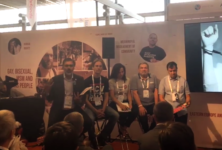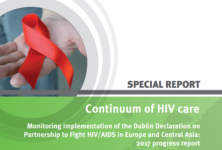The 5th International Symposium on Hepatitis Care in Substance Users (INHSU 2016) got underway Wednesday with an overview of the epidemiology of hepatitis C virus (HCV) among people who inject drugs and a look at public health and harm reduction approaches to preventing, treating, and managing hepatitis C in this often neglected population.
The full conference program, with links to abstracts, is available online. Use hashtag #INHSU2016 to follow conference news live on Twitter.
The conference, sponsored by the International Network on Hepatitis in Substance Users, brought together more than 400 researchers, healthcare providers, and advocates for people who use drugs and people living with hepatitis C. The gathering included several speakers from drug users organizations in Europe and Australia.
Olav Dalgard from Akershus University Hospital opened the meeting, noting that the conference is particularly important at this time due to the advent of effective new interferon-free direct-acting antiviral (DAA) treatment that can cure almost all hepatitis C patients in a few months with few side effects.
With the medical research puzzle largely solved, the focus now turns to broadening access to treatment for the people who need it most, which prominently includes people who inject drugs (PWID). HCV is efficiently transmitted via shared needles and other injection equipment, and a large proportion of PWID become infected with HCV soon after they start to inject.
“The science is clear,” said INHSU president Jason Grebely from the Kirby Institute at the University of New South Wales. “We now need to focus on overcoming barriers to access, and harness latest research to implement programs that work.”
Sharon Hutchinson from Glasgow Caledonian University gave an overview of the burden of HCV infection among PWID. Current estimates suggest that 12.2 million people worldwide currently inject drugs, but reliable data is not available from all areas and the actual number could range from 8 to 22 million. Of these, an estimated 6.3 million have HCV and 1.6 million have HIV. But it is critical not to overlook people who have ever injecting drugs in the past — a much larger population.
Viral hepatitis has become a leading cause of death and disability worldwide, now exceeding HIV, malaria, and tuberculosis. While mortality among people with HIV dropped dramatically following the introduction of effective antiretroviral therapy in the mid-1990s, Hutchinson said it remains to be seen whether we will see HCV-related deaths fall to the same extent after the introduction direct-acting antivirals.
Drug injectors with hepatitis C often have other health risk behaviors including heavy alcohol use and poor diet, which raises the risk of liver disease progression and death due to other cause. Deaths due to overdose are also common.
“Attaining sustained virological response may be an opportunity to focus on other health risks,” Hutchinson suggested. “To eliminate liver disease burden we will need a multi-pronged approach, scaling up therapy but also tackling wider health risk behaviors.”
HCV Prevention
Speakers also addressed primary HCV prevention among PWID who are not yet infected. A growing body of research supports the effectiveness of harm reduction approaches, but these are not yet accessible to all who need them, even in many high-income countries.
Holly Hagan from New York University reviewed research showing that a high coverage of needle and syringe programs (NSPs) plus widely available opioid substitution therapy (OST) can reduce the risk of HCV transmission by about 70%; inadequate coverage, however, is much less effective.
Hagan also noted that sharing cookers, cotton filters, and rinse water for preparing drugs can transmit HCV, along with needles and syringes. In fact, sharing cookers and cotton was an even higher risk than needles in some studies because more people do it. Yet while needle and syringe provision is now an accepted public health intervention, fewer programs provide an adequate supply of related equipment.
The public health field increasing recognizes the benefits of opioid substitution therapy, but it remains political controversial in some areas. Johan Franck from the Karolinska Institute gave an overview of the history of and research supporting OST using methadone, buprenorphine, and prescription heroin. Unfortunately, stimulant substitution has so far not proven very effective.
Matthew Hickman from the University of Bristol gave a talk on HCV treatment-as-prevention. Controlled trials in the HIV field have shown that antiretroviral treatment that reduces viral load to an undetectable level makes it nearly impossible to transmit HIV. Hepatitis C treatment should theoretically be even more effective in this regard, as it actually eliminates HCV, while HIV treatment only suppresses viral replication while on therapy.
Although there is not yet empirical evidence that HCV treatment will reduce transmission, modeling studies indicate that relatively modest scale-ups of treatment could have a major impact on hepatitis C epidemics, influenced by factors such as HCV prevalence in a given population. As such, guidelines increasingly recommend prioritizing treatment for people who are likely to transmit HCV — such as active drug users who share equipment — in addition to people with advanced liver disease.
Ultimately, harm reduction approaches and hepatitis C treatment may not be enough to halt epidemics, and researchers are avidly seeking an HCV vaccine. Andrea Cox from John Hopkins University reviewed this research to date. John-Arne Røttingen from the Norwegian Institute of Public Health followed with a discussion of how lessons from the Ebola epidemic can inform the design of hepatitis C trials.
Developing an HCV vaccine is difficult because the virus is highly variable. While we know that HCV does not confer full protective immunity against reinfection, evidence indicates that some protective immunity does develop, and it appears to get stronger with each subsequent infection. A preventive vaccine candidate is now in clinical trials with data due in early 2017.
“We have a unique opportunity, if we can combine treatment and a vaccine, to accomplish what we can’t do with other disease using one or the other,” Cox concluded.
Several speakers emphasized the importance of involving people who inject drugs in the design of research and the development of prevention and treatment programs.
“We have been too long neglected and seen as a group that can be ignored,” said Ronny Bjørnestad from proLAR, a Norwegian organization for people on OST. “We will no longer tolerate treatments with side effects. We have to increase prevention, start treating people fast, and give treatment to people who are at risk of infecting others, as well as for their own health.”
Saga Rönnlundended the day with a presentation of Liver Or Die, a peer education initiative created by the Swedish Drug Users Union.
“Just as myths are spread we can spread the opposite — correct information,” she said.
By Liz Highleyman
References
S Hutchinson. The Burden of HCV Infection among PWID. 5th International Symposium on Hepatitis Care in Substance Users (INHSU 2016). Oslo, September 7-9, 2016. View abstract.
H Hagan. Sharing of Needles, Syringes and Injecting Equipment: Risk of HCV Transmission and Prevention Potential. 5th International Symposium on Hepatitis Care in Substance Users (INHSU 2016). Oslo, September 7-9, 2016. View abstract.
J Franck. Opioid and Stimulant Substitution Treatment. 5th International Symposium on Hepatitis Care in Substance Users (INHSU 2016). Oslo, September 7-9, 2016. View abstract.
M Hickman. HCV Treatment as Prevention. 5th International Symposium on Hepatitis Care in Substance Users (INHSU 2016). Oslo, September 7-9, 2016.
A Cox. HCV Vaccine Development: Where Do We Stand? 5th International Symposium on Hepatitis Care in Substance Users (INHSU 2016). Oslo, September 7-9, 2016. View abstract.
J-A Røttingen. The Ebola Vaccine Experience: Cluster Randomisation and Implications for HCV Trial Design. 5th International Symposium on Hepatitis Care in Substance Users (INHSU 2016). Oslo, September 7-9, 2016.
S Rönnlund. Liver Or Die: A Peer Training Manual. 5th International Symposium on Hepatitis Care in Substance Users (INHSU 2016). Oslo, September 7-9, 2016. View abstract.
Other Source
INHSU. No Treatment, No Elimination Says New Research. Press release. September 7, 2016.


 ПОИСК ПО САЙТУ
ПОИСК ПО САЙТУ  поиск по ресурсному центру
поиск по ресурсному центру 


